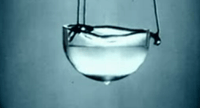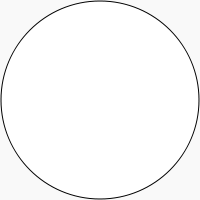Chemicals/Heliums
< Chemicals"C. FRIEDLÄNDER and H. Kayser have independently claimed to have found helium in the [Earth's] atmosphere. On examination of some photographs of the spectrum of neon I have identified six of the principal lines of helium, which thus establishes beyond question the presence of this gas in the air. The amount present in the neon it is, of course, impossible to estimate, but the green line (wave-length 5016 [501.6 nm]) is the brightest, as would be expected from the low pressure of the helium in the neon."[1]
Emissions
Helium has green lines at 501 and 505 nm, while a line at 493 nm is in the cyan and 587 nm is in the yellow.[2]
Note that helium does have emission lines in the blue.
As shown in the above spectrum, helium has at least one emission line in the violet.
The He I emission lines are at 414.3 nm and 447.1 nm.[3]
Gases

Helium is a "colorless and inert gas".[4]
Helium is a noble gas.
Liquids

Liquid helium as shown on the right is just above absolute zero in temperature.
Rocks
"Helium, U, V, and Se make up the dominant group, giving rise to highly anomalous He and U and weakly anomalous V and Se patterns."[5]
Technology

Estimated 2013 U.S. fractional helium use by category. Total use is 47 million cubic meters.[6]
Research
Hypothesis:
- Helium fusion can be accomplished using muons.
Control groups

The findings demonstrate a statistically systematic change from the status quo or the control group.
“In the design of experiments, treatments [or special properties or characteristics] are applied to [or observed in] experimental units in the treatment group(s).[7] In comparative experiments, members of the complementary group, the control group, receive either no treatment or a standard treatment.[8]"[9]
Proof of concept
Def. a “short and/or incomplete realization of a certain method or idea to demonstrate its feasibility"[10] is called a proof of concept.
Def. evidence that demonstrates that a concept is possible is called proof of concept.
The proof-of-concept structure consists of
- background,
- procedures,
- findings, and
- interpretation.[11]
See also
References
- ↑ E. C. C. Baly (October 6, 1898). "Helium in the Atmosphere". Nature 58 (1510): 545. doi:10.1038/058545a0.
- ↑ Barbara Mattson (September 5, 2006). "Solution for Graphing Spectra Student Worksheet, Part II". NASA GSFC, Greenbelt, Maryland, USA: NASA's Imagine the Universe. Retrieved 2013-01-23.
- ↑ Peter S. Conti and Eva M. Leep (October 1974). "Spectroscopic observations of O-type stars. V. The hydrogen lines and lambda 4686 He II". The Astrophysical Journal 193 (10): 113-24. doi:10.1086/153135.
- ↑ "helium, In: Wiktionary". San Francisco, California: Wikimedia Foundation, Inc. October 1, 2013. Retrieved 2013-10-05.
- ↑ Willy Dyck, Dwaine Car (June 1987). "Detailed geochemical studies of a He-U lake anomaly in permafrost, Baker Lake Area, NWT". Journal of Geochemical Exploration 28 (1-3): 409-29. http://www.sciencedirect.com/science/article/pii/0375674287900604. Retrieved 2013-08-28.
- ↑ U.S. Department of the Interior, U.S. Geological Survey (2014). "Helium". Mineral Commodity Summaries 2014. pp. 72–73. http://minerals.usgs.gov/minerals/pubs/commodity/helium/mcs-2014-heliu.pdf.
- ↑ Klaus Hinkelmann, Oscar Kempthorne (2008). Design and Analysis of Experiments, Volume I: Introduction to Experimental Design (2nd ed.). Wiley. ISBN 978-0-471-72756-9. http://books.google.com/?id=T3wWj2kVYZgC&printsec=frontcover.
- ↑ R. A. Bailey (2008). Design of comparative experiments. Cambridge University Press. ISBN 978-0-521-68357-9. http://www.cambridge.org/uk/catalogue/catalogue.asp?isbn=9780521683579.
- ↑ "Treatment and control groups, In: Wikipedia". San Francisco, California: Wikimedia Foundation, Inc. May 18, 2012. Retrieved 2012-05-31.
- ↑ "proof of concept, In: Wiktionary". San Francisco, California: Wikimedia Foundation, Inc. November 10, 2012. Retrieved 2013-01-13.
- ↑ Ginger Lehrman and Ian B Hogue, Sarah Palmer, Cheryl Jennings, Celsa A Spina, Ann Wiegand, Alan L Landay, Robert W Coombs, Douglas D Richman, John W Mellors, John M Coffin, Ronald J Bosch, David M Margolis (August 13, 2005). "Depletion of latent HIV-1 infection in vivo: a proof-of-concept study". Lancet 366 (9485): 549-55. doi:10.1016/S0140-6736(05)67098-5. http://www.ncbi.nlm.nih.gov/pmc/articles/PMC1894952/. Retrieved 2012-05-09.
External links
| |||||||||||||||||||||||||||||||||||
![]() This is a research project at http://en.wikiversity.org
This is a research project at http://en.wikiversity.org
| |
Development status: this resource is experimental in nature. |
| |
Educational level: this is a research resource. |
| |
Resource type: this resource is an article. |
| |
Resource type: this resource contains a lecture or lecture notes. |
| |
Subject classification: this is a chemistry resource . |
